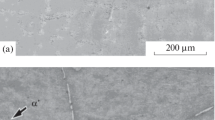Conclusions
-
1.
In determining the resistance of a carburized layer to pit formation, the temperature at which the steel is heated for quenching relative to the points Ac1 and Acm, and the amount of carbon and alloying elements dissolved in the solid solution should be considered in addition to established notions concerning the influence exerted by the amount of residual austenite and the carbon concentration in the layer on the contact-fatigue strength.
-
2.
Multiple regression analysis of the results of phase analysis made it possible to establish general laws and quantitative relationships between the content of alloying elements in the solid solution after quenching steel from various temperatures and the contact-fatigue strength.
-
3.
An increase in each of the factors under consideration (quench temperature, and the amount of carbon and alloying elements in the solid solution) initially leads to an improvment in the contact-fatigue strength, and causes it to diminish after the maximum has been attained. This can be explained by variation in the phase-structure composition of the layer and in the nature of hardening of the structures that are formed.
-
4.
The carburized layer on steel 18KhGNMFL exhibits maximum contact-fatigue strength in cases where 0.8% of C and 3.5% of alloying elements are dissolved in the solid solution after quenching from the temperature corresponding to the point Acm.
Similar content being viewed by others
Literature cited
Inventor's Certificate No. 516757, MKI S 22 S 38/00, Carburizing Cast Steel.
B. B. Vinokur, S. E. Kondratyuk, L. I. Markovskaya, et al., "Effect of residual austenite on the contact endurance of carburizing steel," Metalloved. Term. Obrab. Met., No. 11, 47–49 (1978).
B. B. Vinokur, S. E. Kondratyuk, R. A. Khrunik, et al., "Effect of carbon on the contact endurance of carburizing steel," Fiz.-Khim. Mekh. Mater., No. 2, 96–98 (1986).
B. B. Vinokur, S. E. Kondratyuk, L. I. Markovskaya, et al., "Contact endurance of carburizing cast steel," Fiz.-Khim. Mekh. Mater., No. 1, 86–89 (1978).
B. B. Vinokur and V. L. Pilyushenko, Strength and Brittleness of Structural Alloy Steel [in Russian], Naukova Dumka, Kiev (1983).
A. B. Kuslitskii, Nonmetallic Inclusions and Steel Fatigue [in Russian], Tekhnika, Kiev (1976).
Additional information
Institute of Casting Problems, Academy of Sciences of the Ukrainian SSR. E. O. Paton Institute of Electric Welding. Translated from Metallovedenie i Termicheskaya Obrabotka Metallov, No. 10, pp. 30–32, October, 1987.
Rights and permissions
About this article
Cite this article
Vinokur, B.B., Kondratyuk, S.E. & Kasatkin, O.G. Effect of the degree of alloying of the solid solution on the contact-fatigue strength of the carburized layer. Met Sci Heat Treat 29, 753–756 (1987). https://doi.org/10.1007/BF00707733
Issue Date:
DOI: https://doi.org/10.1007/BF00707733




